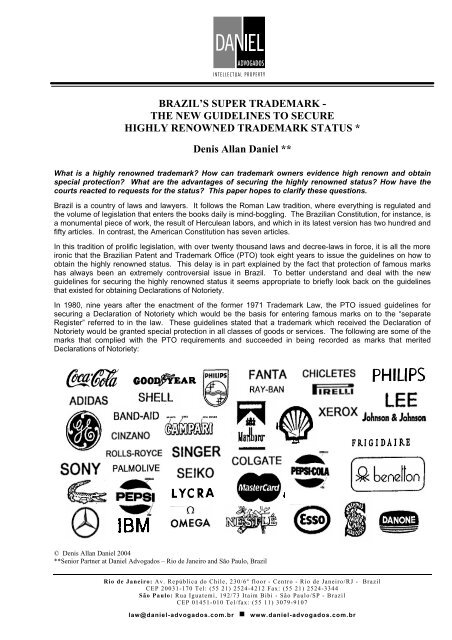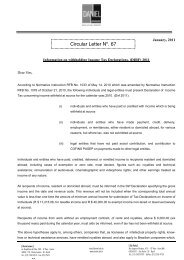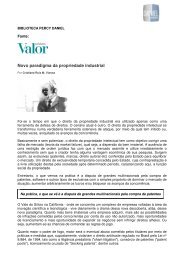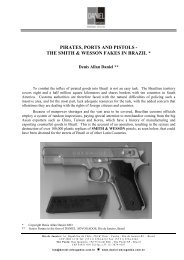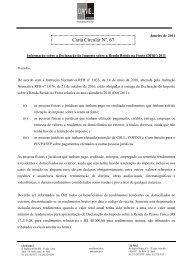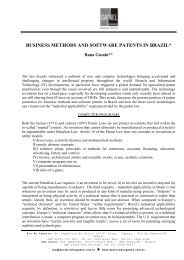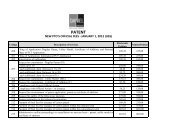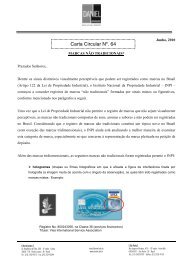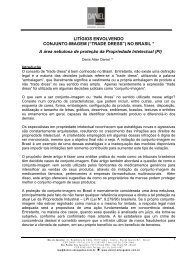brazil's super trademarks or the highly renowned - Daniel Advogados
brazil's super trademarks or the highly renowned - Daniel Advogados
brazil's super trademarks or the highly renowned - Daniel Advogados
You also want an ePaper? Increase the reach of your titles
YUMPU automatically turns print PDFs into web optimized ePapers that Google loves.
BRAZIL’S SUPER TRADEMARK -THE NEW GUIDELINES TO SECUREHIGHLY RENOWNED TRADEMARK STATUS *Denis Allan <strong>Daniel</strong> **What is a <strong>highly</strong> <strong>renowned</strong> trademark? How can trademark owners evidence high renown and obtainspecial protection? What are <strong>the</strong> advantages of securing <strong>the</strong> <strong>highly</strong> <strong>renowned</strong> status? How have <strong>the</strong>courts reacted to requests f<strong>or</strong> <strong>the</strong> status? This paper hopes to clarify <strong>the</strong>se questions.Brazil is a country of laws and lawyers. It follows <strong>the</strong> Roman Law tradition, where everything is regulated and<strong>the</strong> volume of legislation that enters <strong>the</strong> books daily is mind-boggling. The Brazilian Constitution, f<strong>or</strong> instance, isa monumental piece of w<strong>or</strong>k, <strong>the</strong> result of Herculean lab<strong>or</strong>s, and which in its latest version has two hundred andfifty articles. In contrast, <strong>the</strong> American Constitution has seven articles.In this tradition of prolific legislation, with over twenty thousand laws and decree-laws in f<strong>or</strong>ce, it is all <strong>the</strong> m<strong>or</strong>eironic that <strong>the</strong> Brazilian Patent and Trademark Office (PTO) took eight years to issue <strong>the</strong> guidelines on how toobtain <strong>the</strong> <strong>highly</strong> <strong>renowned</strong> status. This delay is in part explained by <strong>the</strong> fact that protection of famous markshas always been an extremely controversial issue in Brazil. To better understand and deal with <strong>the</strong> newguidelines f<strong>or</strong> securing <strong>the</strong> <strong>highly</strong> <strong>renowned</strong> status it seems appropriate to briefly look back on <strong>the</strong> guidelinesthat existed f<strong>or</strong> obtaining Declarations of Not<strong>or</strong>iety.In 1980, nine years after <strong>the</strong> enactment of <strong>the</strong> f<strong>or</strong>mer 1971 Trademark Law, <strong>the</strong> PTO issued guidelines f<strong>or</strong>securing a Declaration of Not<strong>or</strong>iety which would be <strong>the</strong> basis f<strong>or</strong> entering famous marks on to <strong>the</strong> “separateRegister” referred to in <strong>the</strong> law. These guidelines stated that a trademark which received <strong>the</strong> Declaration ofNot<strong>or</strong>iety would be granted special protection in all classes of goods <strong>or</strong> services. The following are some of <strong>the</strong>marks that complied with <strong>the</strong> PTO requirements and succeeded in being rec<strong>or</strong>ded as marks that meritedDeclarations of Not<strong>or</strong>iety:© Denis Allan <strong>Daniel</strong> 2004**Seni<strong>or</strong> Partner at <strong>Daniel</strong> <strong>Advogados</strong> – Rio de Janeiro and São Paulo, BrazilRio de Janeiro: Av. República do Chile, 230/6º flo<strong>or</strong> - Centro - Rio de Janeiro/RJ - BrazilCEP 20031-170 Tel: (55 21) 2524-4212 Fax: (55 21) 2524-3344São Paulo: Rua Iguatemi, 192/73 Itaim Bibi - São Paulo/SP - BrazilCEP 01451-010 Tel/fax: (55 11) 3079-9107law@daniel-advogados.com.br g www.daniel-advogados.com.br
Subsequently to <strong>the</strong>se guidelines, in 1994 <strong>the</strong> PTO issued Trademark Directives which provided helpful insightinto <strong>the</strong> subject involving <strong>the</strong> submission of inf<strong>or</strong>mation f<strong>or</strong> <strong>the</strong> purpose of obtaining <strong>the</strong> Declaration. TheDirectives stated that, of all <strong>the</strong> inf<strong>or</strong>mation that could be submitted f<strong>or</strong> this purpose, <strong>the</strong> most imp<strong>or</strong>tant andeffective would be <strong>the</strong> results of public opinion polls. Undoubtedly, opinion polls were at that time successfullyused by trademark owners to convince PTO Examiners that Declarations should be granted f<strong>or</strong> extra protectionof <strong>the</strong>ir famous <strong>trademarks</strong>.With this background, we come to <strong>the</strong> 1996 Trademark Law which introduced <strong>the</strong> concept of <strong>the</strong> “<strong>super</strong>trademark” <strong>or</strong> <strong>the</strong> <strong>highly</strong> <strong>renowned</strong> trademark. We also come to <strong>the</strong> eagerly awaited new guidelines, publishedon 3 February 2004, f<strong>or</strong> securing this status.What is a Highly Renowned Trademark ?The current 1996 Law contains no definition. It merely states that a trademark which is registered in Brazil, andis considered <strong>highly</strong> <strong>renowned</strong>, shall be assured protection in all fields of activity, meaning in all classes ofgoods and services of <strong>the</strong> International Classification, adopted by Brazil. It must not be confused with a wellknowntrademark acc<strong>or</strong>ding to <strong>the</strong> provisions of Article 6bis of <strong>the</strong> Paris Convention. In this latter case, <strong>the</strong>trademark must be well-known in its field of activity and does not merit protection in all fields of activity. Unlike<strong>the</strong> <strong>highly</strong> <strong>renowned</strong> trademark which must be registered in Brazil, a well-known mark does not have to beregistered <strong>or</strong> pending in Brazil to deserve protection.In <strong>the</strong> absence of any definition in <strong>the</strong> law, <strong>the</strong> alternative is to rely on opinions, ei<strong>the</strong>r by PTO officials <strong>or</strong> by <strong>the</strong>courts, rendered during any specific proceedings involving requests f<strong>or</strong> <strong>highly</strong> <strong>renowned</strong> status. The DAKOTAcase, m<strong>or</strong>e details of which will be rep<strong>or</strong>ted fur<strong>the</strong>r on, provides a definition that was rendered in 1999 by <strong>the</strong><strong>the</strong>n Att<strong>or</strong>ney-General of <strong>the</strong> PTO. He declared, in his opinion to <strong>the</strong> court, that <strong>the</strong> mark DAKOTA deserved<strong>the</strong> <strong>highly</strong> <strong>renowned</strong> status in view of <strong>the</strong> evidence that was submitted. He specifically described <strong>highly</strong><strong>renowned</strong> <strong>trademarks</strong> when he stated <strong>the</strong> following: “In principle, it cannot be denied that <strong>the</strong> markDAKOTA, as demonstrated by <strong>the</strong> plaintiff’s brief, has reached <strong>the</strong> appropriate degree of recognition, at<strong>the</strong> national territ<strong>or</strong>ial level, as well as abroad. And, this being so, it shows that this mark goes beyond<strong>the</strong> limits of a n<strong>or</strong>mal trademark, providing benefit to various consumers, in all social classes, not onlydue to its fame and reputation, but also presuppositions as to <strong>the</strong> quality of <strong>the</strong> product it identifies.Without doubt, <strong>the</strong> spirit of a <strong>highly</strong> <strong>renowned</strong> mark, even if still in <strong>the</strong> absence of guidelines, is toinclude, among o<strong>the</strong>r requirements, that it be a strong mark, known in all social strata and especially tobe a product of impeccable quality.”It would seem that if we are to be guided by <strong>the</strong> f<strong>or</strong>mer Att<strong>or</strong>ney-General’s opinion, a <strong>highly</strong> <strong>renowned</strong>trademark could be defined as a trademark that has an extremely high degree of recognition amongstconsumers of all social classes, not only in Brazil but also abroad, due not only to its fame and reputation, butalso to <strong>the</strong> exceptional quality of <strong>the</strong> goods <strong>or</strong> services it identifies. The new guidelines which outline <strong>the</strong>evidence to be presented to show <strong>highly</strong> <strong>renowned</strong> status confirm this understanding.How can Trademark Owners Evidence High Renownand Obtain Special Protection?While <strong>the</strong> 1980 guidelines f<strong>or</strong> filing a request f<strong>or</strong> a Declaration of Not<strong>or</strong>iety stated that an application had to befiled requesting <strong>the</strong> PTO to officially declare that <strong>the</strong> mark was well-known and to issue a Declaration ofNot<strong>or</strong>iety, <strong>the</strong> new guidelines stipulate that a claim to <strong>highly</strong> <strong>renowned</strong> status can only be made incidentally,when filing opposition <strong>or</strong> administrative nullity proceedings. There is no o<strong>the</strong>r way in which such a claim can bemade. If <strong>the</strong> mark is regarded as being <strong>highly</strong> <strong>renowned</strong>, <strong>the</strong> PTO will sustain <strong>the</strong> opposition <strong>or</strong> <strong>the</strong>administrative nullity proceedings and will reject <strong>the</strong> trademark application <strong>or</strong> declare null a registration,irrespective of o<strong>the</strong>r arguments that are submitted. If <strong>the</strong> mark is not regarded as <strong>highly</strong> <strong>renowned</strong>, <strong>the</strong> PTOshall reject <strong>the</strong> opposition <strong>or</strong> <strong>the</strong> administrative nullity proceedings and will allow <strong>the</strong> trademark application <strong>or</strong>maintain <strong>the</strong> trademark registration, unless <strong>the</strong>re are o<strong>the</strong>r grounds f<strong>or</strong> impediment.When filing an opposition <strong>or</strong> administrative nullity proceeding, <strong>the</strong> applicant must submit evidence to show that<strong>the</strong> mark should be considered <strong>highly</strong> <strong>renowned</strong>. The following is <strong>the</strong> inf<strong>or</strong>mation that <strong>the</strong> guidelines state maybe submitted:2
1. date of first use of <strong>the</strong> mark in Brazil;2. description of <strong>the</strong> consumer <strong>or</strong> market potential consumer of <strong>the</strong> products <strong>or</strong> services to which <strong>the</strong> mark isapplied;3. identification by means of an opinion poll, market survey <strong>or</strong> by any o<strong>the</strong>r applicable means <strong>the</strong> fraction of<strong>the</strong> consumers <strong>or</strong> potential consumers of <strong>the</strong> products <strong>or</strong> services to which <strong>the</strong> mark is applied thatimmediately and spontaneously identify <strong>the</strong> mark and associate it with <strong>the</strong> products <strong>or</strong> services to which it isapplied, essentially by reason of its tradition and fav<strong>or</strong>able market perception;4. identification by means of an opinion poll, market survey <strong>or</strong> by any o<strong>the</strong>r applicable means <strong>the</strong> fraction ofconsumers from o<strong>the</strong>r market segments who immediately and spontaneously identify <strong>the</strong> mark with <strong>the</strong>products <strong>or</strong> services to which it is applied;5. identification by means of an opinion poll, market survey <strong>or</strong> by any o<strong>the</strong>r applicable means <strong>the</strong> fraction ofconsumers from o<strong>the</strong>r market segments who immediately and spontaneously identify <strong>the</strong> mark with <strong>the</strong>products <strong>or</strong> services to which it is applied, due to its tradition and rank in <strong>the</strong> marketplace;6. methods of commercialization of <strong>the</strong> goods/services identified by <strong>the</strong> mark in Brazil;7. geographical area of <strong>the</strong> actual sale of <strong>the</strong> products/services identified by <strong>the</strong> mark in Brazil and, possiblyabroad;8. time span of <strong>the</strong> actual use of <strong>the</strong> mark in <strong>the</strong> national market and, possibly, in <strong>the</strong> international market;9. methods of dissemination of <strong>the</strong> mark in Brazil and, possibly, abroad;10. time span of effective divulging of <strong>the</strong> mark in Brazil and, possibly, abroad;11. amount invested by <strong>the</strong> owner in publicity/advertisement of <strong>the</strong> mark in <strong>the</strong> Brazilian media during <strong>the</strong> lastthree (3) years;12. volume of sales of <strong>the</strong> product <strong>or</strong> <strong>the</strong> revenue accrued from <strong>the</strong> service during <strong>the</strong> last three (3) years and13. economic value of <strong>the</strong> mark in <strong>the</strong> company’s assets.Of all <strong>the</strong> inf<strong>or</strong>mation listed in <strong>the</strong> new guidelines, <strong>the</strong> securing of a public opinion poll <strong>or</strong> market survey shouldbe given top pri<strong>or</strong>ity. Three suggested market surveys have appeared in <strong>the</strong> guidelines, a definite sign that <strong>the</strong>results of <strong>the</strong>se surveys will have a strong bearing on <strong>the</strong> individual opinions of <strong>the</strong> representatives of <strong>the</strong> PTOSpecial Committee that will examine and decide <strong>the</strong> matter. The fact that <strong>the</strong> PTO expressly declaredpreference in <strong>the</strong> past f<strong>or</strong> market surveys to grant Declarations of Not<strong>or</strong>iety should lend strong supp<strong>or</strong>t f<strong>or</strong> thisview. Once a trademark receives official recognition that it is <strong>highly</strong> <strong>renowned</strong>, rec<strong>or</strong>dal to this effect will beentered in <strong>the</strong> Trademark Register f<strong>or</strong> a term of five years.What are <strong>the</strong> Advantages in Securing <strong>the</strong> Highly Renowned Status ?The first advantage that comes to mind, at <strong>the</strong> administrative level, is that once a trademark is officially declaredto be <strong>highly</strong> <strong>renowned</strong> it will greatly facilitate <strong>the</strong> rejection of objectionable third party applications. This does notmean, however, that <strong>the</strong>re is any guarantee that <strong>the</strong> PTO will automatically reject a third party application thatconflicts with <strong>the</strong> <strong>highly</strong> <strong>renowned</strong> trademark, once it is official recognized as such. At court high renown statuswould enhance <strong>the</strong> chances of securing injunctions, not to mention those of achieving success when <strong>the</strong> courtaction is examined on its merits, since <strong>the</strong> courts should certainly be m<strong>or</strong>e fav<strong>or</strong>able to <strong>the</strong> plaintiff’s causewhen <strong>the</strong> basis f<strong>or</strong> <strong>the</strong> action is a mark held by <strong>the</strong> PTO to be <strong>highly</strong> <strong>renowned</strong>. A fur<strong>the</strong>r advantage is that <strong>the</strong>imprisonment sanctions f<strong>or</strong>eseen f<strong>or</strong> crimes against <strong>trademarks</strong> are increased by one third to one half if <strong>the</strong>altered, reproduced <strong>or</strong> imitated trademark is <strong>highly</strong> <strong>renowned</strong>. A still fur<strong>the</strong>r advantage is that once <strong>the</strong> <strong>highly</strong><strong>renowned</strong> status of <strong>the</strong> mark is accepted under <strong>the</strong> guidelines, <strong>the</strong> PTO is required to inf<strong>or</strong>m FAPESP, <strong>the</strong>official agency responsible f<strong>or</strong> <strong>the</strong> registration of domain names, f<strong>or</strong> <strong>the</strong> purpose of rejecting any applications f<strong>or</strong>domain names that may conflict with <strong>the</strong> <strong>highly</strong> <strong>renowned</strong> mark. Finally, since <strong>the</strong> guidelines f<strong>or</strong> securing <strong>the</strong><strong>highly</strong> <strong>renowned</strong> status indicate that inf<strong>or</strong>mation regarding <strong>the</strong> economic value of <strong>the</strong> trademark, in <strong>the</strong>company’s assets, should be submitted, this could cause an increase in <strong>the</strong> goodwill associated to <strong>the</strong>trademark.3
How have <strong>the</strong> Courts Reacted to Requests f<strong>or</strong> <strong>the</strong> Status ?Due to <strong>the</strong> reluctance of <strong>the</strong> PTO to decide on how it would deal with <strong>the</strong> issue of <strong>highly</strong> <strong>renowned</strong> <strong>trademarks</strong>,a few companies decided, pri<strong>or</strong> to <strong>the</strong> existence of <strong>the</strong> guidelines that have now issued, to test <strong>the</strong> courts in <strong>the</strong>hope that <strong>the</strong>y would succeed in obtaining what <strong>the</strong> PTO refused to grant. Four known decisions have beenrendered on <strong>the</strong>se attempts and this is a summary of <strong>the</strong>ir status.The DAKOTA CaseThis can be considered <strong>the</strong> leading case and deserves m<strong>or</strong>e detailed comment. The DAKOTA trademark isregistered in Brazil f<strong>or</strong> shoes and <strong>the</strong> owner, a well-known Brazilian shoe manufacturer, became frustratedbecause <strong>the</strong> PTO refused to grant <strong>the</strong> <strong>highly</strong> <strong>renowned</strong> status. To aggravate <strong>the</strong> problem, it was alleged thatcompetit<strong>or</strong>s were attempting to register similar marks such as, f<strong>or</strong> example, DACOTA f<strong>or</strong> goods o<strong>the</strong>r thanshoes and <strong>the</strong> PTO was refusing to reject <strong>the</strong>se applications. This was adversely affecting <strong>the</strong> company’sbusiness. The company opted f<strong>or</strong> instituting court proceedings and submitted, as evidence of fame andreputation of <strong>the</strong> mark DAKOTA, <strong>the</strong> following: a) profiles of <strong>the</strong> eight industrial units that <strong>the</strong> company ownsin several different locations in <strong>the</strong> States of Rio Grande do Sul and Ceará; b) sales figures showing thatannual sales increased from nine million US dollars in 1988 to two hundred and thirty million US dollars in 1997;c) extensive advertising material, including <strong>the</strong> cost f<strong>or</strong> investment in marketing in leading magazines with overa million readers f<strong>or</strong> each edition of <strong>the</strong>se magazines; d) sales invoices showing sales of DAKOTA shoes,throughout Brazil and in Japan, <strong>the</strong> Czech Republic, Ecuad<strong>or</strong>, Saudi Arabia, Uruguay, Bolivia, Paraguay and<strong>the</strong> Margarita Islands; e) voluminous material showing declarations from consumers, businessmen, classentities and auth<strong>or</strong>ities attesting to <strong>the</strong> knowledge, prestige, fame and reputation of <strong>the</strong> mark DAKOTA; f)clippings taken from publications in newspapers and magazines providing inf<strong>or</strong>mation on <strong>the</strong> company and on<strong>the</strong> DAKOTA mark. The plaintiff’s petition to <strong>the</strong> court requested that, in view of <strong>the</strong> evidence submitted, <strong>the</strong>case be referred to <strong>the</strong> PTO f<strong>or</strong> its reply and that <strong>the</strong> action be sustained. In a sh<strong>or</strong>t reply, based on an opinionrendered by <strong>the</strong> Att<strong>or</strong>ney General’s office, <strong>the</strong> PTO agreed that <strong>the</strong> mark DAKOTA was indeed <strong>highly</strong> <strong>renowned</strong>and deserved <strong>the</strong> special protection in all fields of activity. The court rendered its fav<strong>or</strong>able decision which <strong>the</strong>Federal Court in Rio de Janeiro confirmed on 7 November 2000.The GOODYEAR CaseIn this case, The Goodyear Tire & Rubber Company filed a court action requesting that <strong>the</strong> mark GOODYEARbe held <strong>highly</strong> <strong>renowned</strong>. Evidence submitted by <strong>the</strong> plaintiff was accepted and a decision was rendered on 2December 2002 conferring <strong>the</strong> <strong>highly</strong> <strong>renowned</strong> status to <strong>the</strong> mark. The case is now awaiting <strong>the</strong> necessaryconfirmation of <strong>the</strong> decision by a higher court.The LYCRA CaseThe court rejected <strong>the</strong> request f<strong>or</strong> <strong>the</strong> <strong>highly</strong> <strong>renowned</strong> status f<strong>or</strong> <strong>the</strong> mark LYCRA, owned by E.I. Du Pont deNemours and Company, on <strong>the</strong> grounds that <strong>the</strong> framers of <strong>the</strong> current Trademark Law opted to give <strong>the</strong> <strong>highly</strong><strong>renowned</strong> trademark a different treatment from <strong>the</strong> one given to well-known marks, as referred to in <strong>the</strong> f<strong>or</strong>mer1971 Law and <strong>the</strong>ref<strong>or</strong>e revoked <strong>the</strong> “separate Register” f<strong>or</strong> well-known marks provided f<strong>or</strong> in said f<strong>or</strong>mer Law.A decision was rendered on 4 June 2003 which is now under appeal.The BIC CaseThe court decision in <strong>the</strong> preliminary injunction filed in this case made a distinction between well-known marksunder <strong>the</strong> 1971 Trademark Law and <strong>the</strong> <strong>highly</strong> <strong>renowned</strong> mark under <strong>the</strong> current 1996 Law. The injunction wasdismissed on 4 June 2003 and <strong>the</strong> plaintiff filed an interlocut<strong>or</strong>y appeal. The Federal Court of appeal, in itsdecision dated 30 June 2003, declared that <strong>the</strong>re was no indication that third parties were attempting to registermarks that might conflict with <strong>the</strong> mark BIC, a fact that removes imminent risk of difficult <strong>or</strong> impossiblereparation, <strong>the</strong>se being <strong>the</strong> basic pre-requisites f<strong>or</strong> granting an injunction. This case will now proceed to a finaldecision on its merits.These four inconsistent reactions of <strong>the</strong> courts relating to substantially <strong>the</strong> same pleas, are an indication of howdifficult it is to predict how Brazilian courts will react to any IP issues. On <strong>the</strong> specific issue of protection of wellknownmarks, <strong>the</strong> changes in <strong>the</strong> Trademark Law, coupled with <strong>the</strong> difficulty in having <strong>the</strong> courts understand <strong>the</strong>different concepts of famous marks, are additional fact<strong>or</strong>s that contribute to prevent a m<strong>or</strong>e consistent ruling by<strong>the</strong> courts on <strong>the</strong> matter concerning requests f<strong>or</strong> <strong>highly</strong> <strong>renowned</strong> trademark status.4
ConclusionThe imp<strong>or</strong>tance of <strong>the</strong> new guidelines issued by <strong>the</strong> Brazilian PTO should not be underestimated. Practitionershave long waited f<strong>or</strong> <strong>the</strong>m and eff<strong>or</strong>ts to secure <strong>the</strong> <strong>highly</strong> <strong>renowned</strong> status f<strong>or</strong> a registered trademark should begiven careful consideration since <strong>the</strong> advantages in doing so are m<strong>or</strong>e than evident. It is expected that manydoubts will be raised regarding <strong>the</strong> practical implementation of <strong>the</strong> guidelines and much will depend on <strong>the</strong>criteria adopted by <strong>the</strong> PTO’s Special Committee in deciding <strong>the</strong> specific cases as <strong>the</strong>y are presented. Of all<strong>the</strong> inf<strong>or</strong>mation suggested in <strong>the</strong> PTO guidelines to supp<strong>or</strong>t <strong>the</strong> argument that a trademark should be granted<strong>the</strong> <strong>highly</strong> <strong>renowned</strong> status, public opinion polls <strong>or</strong> market surveys should appear at <strong>the</strong> top of <strong>the</strong> list. It shouldbe remembered that requests f<strong>or</strong> <strong>highly</strong> <strong>renowned</strong> status can only be made when oppositions <strong>or</strong> administrativenullity proceedings are filed and <strong>the</strong>ref<strong>or</strong>e no time should be lost in assembling <strong>the</strong> inf<strong>or</strong>mation that is called f<strong>or</strong>in <strong>the</strong> guidelines. Since this can be time consuming and <strong>the</strong> need to oppose third party applications can arise atany moment, time is of <strong>the</strong> essence. The inconsistent outcome of <strong>the</strong> court actions filed to secure <strong>the</strong> <strong>highly</strong><strong>renowned</strong> status would seem to lead to <strong>the</strong> conclusion that litigation should only be considered as a last res<strong>or</strong>t if<strong>the</strong> PTO rejects requests at <strong>the</strong> administrative level. There is no denying that <strong>the</strong> guidelines represent a stepf<strong>or</strong>ward in <strong>the</strong> protection of what could be termed Brazil’s “<strong>super</strong> trademark” and should be welcomed by all whopractice bef<strong>or</strong>e <strong>the</strong> PTO and by all propriet<strong>or</strong>s of famous registered <strong>trademarks</strong> in Brazil.5


